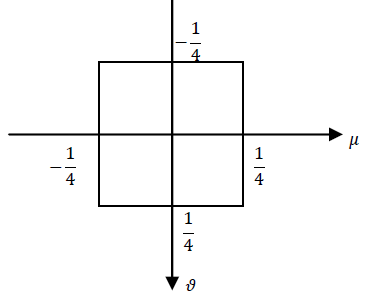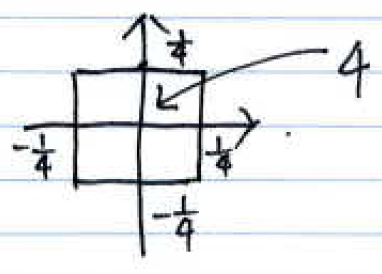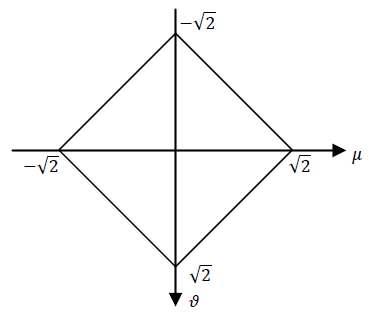| Line 66: | Line 66: | ||
</math><br> | </math><br> | ||
| − | [[Image:. | + | [[Image:QE_11_CS5_1_b.png]] |
---- | ---- | ||
| Line 76: | Line 76: | ||
</math> | </math> | ||
| − | [[Image:. | + | [[Image:QE_11_CS5_1_b_sol2.PNG]] |
| Line 133: | Line 133: | ||
<math>\color{blue}\text{Solution 1:}</math> | <math>\color{blue}\text{Solution 1:}</math> | ||
| − | [[Image:. | + | [[Image:QE_11_CS5_1_d.PNG]] |
---- | ---- | ||
| Line 143: | Line 143: | ||
</math> | </math> | ||
| − | [[Image:. | + | [[Image:QE_11_CS5_1_d_sol2.PNG]] |
---- | ---- | ||
Revision as of 15:19, 31 July 2012
ECE Ph.D. Qualifying Exam in "Communication, Networks, Signal, and Image Processing" (CS)
Question 5, August 2011, Part 1
- Part 1,2]
$ \color{blue}\text{Consider the following discrete space system with input } x(m,n) \text{ and output } y(m,n). $
$ \color{blue} y(m,n) = \sum_{k=-\infty}^{\infty}{\sum_{l=-\infty}^{\infty}{x(m-k,n-l)h(k,l)}}. $
$ \color{blue} \text{For parts a) and b) let} $
$ \color{blue} h(m,n)=sinc(mT,nT) $
$ \color{blue} \text{where } T\leq1. $
$ \color{blue} \text{For parts c), d), and e) let} $
$ \color{blue} h(m,n)=sinc\left( \frac{(n+m)T}{\sqrt[]{2}},\frac{(n-m)T}{\sqrt[]{2}} \right) $
$ \color{blue} \text{where } T\leq1. $
$ \color{blue}\text{a) Calculate the frequency response, }H \left( e^{j\mu},e^{j\nu} \right). $
$ \color{blue}\text{Solution 1:} $
$ H(e^{j\mu},e^{j\nu}) = \frac{1}{T^2} rect(\frac{\mu}{T},\frac{\nu}{T}) $
$ \color{blue}\text{Solution 2:} $
$ sinc(m,n) \rightarrow rect(\mu)rect(\nu) $
$ \Rightarrow sinc(mT,nT) \rightarrow \frac{1}{T^2}rect(\frac{\mu}{T})rect(\frac{\nu}{T}) $
$ H(e^{j\mu},e^{j\nu}) $
$ \color{blue}\text{b) Sketch the frequency response for } |\mu| < 2\pi \text{ and } |nu| < 2\pi \text{ when } T = \frac{1}{2} $
$ \color{blue}\text{Solution 2:} $
$ T = \frac{1}{2}, H(e^{j\mu},e^{j\nu}) = 4rect(2\mu)rect(\nu) $
$ \color{blue}\text{c) Calculate the frequency response, }H \left( e^{j\mu},e^{j\nu} \right). $
$ \color{blue}\text{Solution 1:} $
$ H(e^{j\mu},e^{j\nu}) = \frac{1}{T^2} rect \left ( \frac{(\mu + \nu)}{\sqrt{2}T},\frac{(\nu - \mu)}{\sqrt{2}T} \right ) $
$ \color{blue}\text{Solution 2:} $
$ \left ( \frac{(n + m)T}{\sqrt{2}},\frac{(n - m)T}{\sqrt{2}} \right) = \begin{bmatrix} \frac{1}{\sqrt{2}} &\frac{1}{\sqrt{2}} \\ -\frac{1}{\sqrt{2}} &\frac{1}{\sqrt{2}} \end{bmatrix} = \begin{pmatrix} mT\\ nT \end{pmatrix} = A \cdot \begin{pmatrix} mT\\ nT \end{pmatrix} $
$ \text{As } |A| = 1, A^{-1} = A^T, sinc \left( A \begin{pmatrix} mT\\ nT \end{pmatrix} \right) \overset{\mathcal{F}}{\rightarrow} F \left( A \begin{pmatrix} \mu\\ \nu \end{pmatrix} \right) $
$ = \frac{1}{T^2} rect \left ( \frac{(\mu + \nu)}{\sqrt{2}T},\frac{(\nu - \mu)}{\sqrt{2}T} \right ) $
$ \color{blue}\text{d) Sketch the frequency response for } |\mu| < 2\pi \text{ and } |nu| < 2\pi \text{ when } T = \frac{1}{2} $
$ \color{blue}\text{Solution 1:} $
$ \color{blue}\text{Solution 2:} $
$ T = \frac{1}{2}, H(e^{j\mu},e^{j\nu}) = 4rect(\sqrt{2}(\mu + \nu))rect(\sqrt{2}(\nu - \mu)) $
$ \color{blue}\text{e) Calculate } y(m,n) \text{ when } x(m,n)=1. $
$ \color{blue}\text{Solution 1:} $
$ Y(e^{j\mu},e^{j\nu}) = \delta(e^{j\mu},e^{j\nu}) \cdot H(e^{j\mu},e^{j\nu}) $
$ = \frac{1}{T^2} rect (0,0) = 4 $
$ \Rightarrow y(m,n) = 4\delta(m,n) $
$ \color{blue}\text{Solution 2:} $
$ y(m,n) = x(m,n) \cdot H(e^{j0},e^{j0}) = 4 $
"Communication, Networks, Signal, and Image Processing" (CS)- Question 5, August 2011
Go to
- Part 1: solutions and discussions
- Part 2: solutions and discussions





